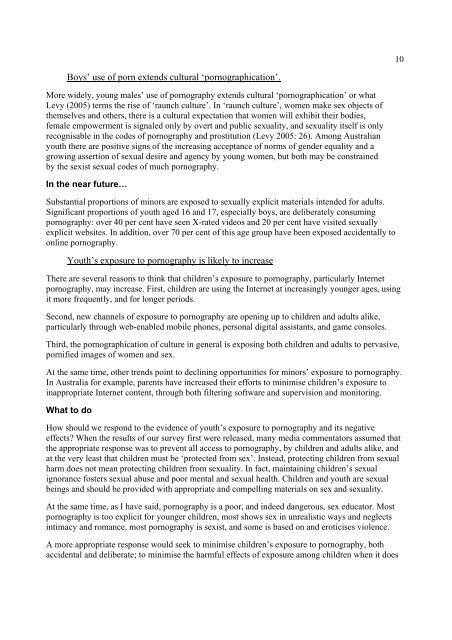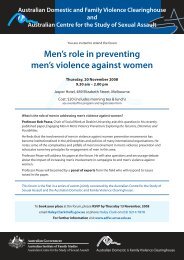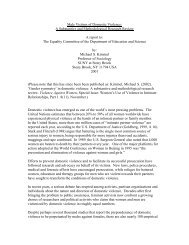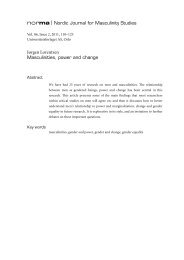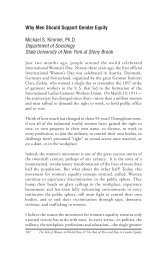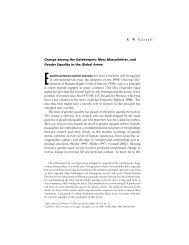Boys, Sex, and Porn: New technologies and old dangers - XY online
Boys, Sex, and Porn: New technologies and old dangers - XY online
Boys, Sex, and Porn: New technologies and old dangers - XY online
You also want an ePaper? Increase the reach of your titles
YUMPU automatically turns print PDFs into web optimized ePapers that Google loves.
<strong>Boys</strong>’ use of porn extends cultural ‘pornographication’.<br />
More widely, young males’ use of pornography extends cultural ‘pornographication’ or what<br />
Levy (2005) terms the rise of ‘raunch culture’. In ‘raunch culture’, women make sex objects of<br />
themselves <strong>and</strong> others, there is a cultural expectation that women will exhibit their bodies,<br />
female empowerment is signaled only by overt <strong>and</strong> public sexuality, <strong>and</strong> sexuality itself is only<br />
recognisable in the codes of pornography <strong>and</strong> prostitution (Levy 2005: 26). Among Australian<br />
youth there are positive signs of the increasing acceptance of norms of gender equality <strong>and</strong> a<br />
growing assertion of sexual desire <strong>and</strong> agency by young women, but both may be constrained<br />
by the sexist sexual codes of much pornography.<br />
In the near future…<br />
Substantial proportions of minors are exposed to sexually explicit materials intended for adults.<br />
Significant proportions of youth aged 16 <strong>and</strong> 17, especially boys, are deliberately consuming<br />
pornography: over 40 per cent have seen X-rated videos <strong>and</strong> 20 per cent have visited sexually<br />
explicit websites. In addition, over 70 per cent of this age group have been exposed accidentally to<br />
<strong>online</strong> pornography.<br />
Youth’s exposure to pornography is likely to increase<br />
There are several reasons to think that children’s exposure to pornography, particularly Internet<br />
pornography, may increase. First, children are using the Internet at increasingly younger ages, using<br />
it more frequently, <strong>and</strong> for longer periods.<br />
Second, new channels of exposure to pornography are opening up to children <strong>and</strong> adults alike,<br />
particularly through web-enabled mobile phones, personal digital assistants, <strong>and</strong> game consoles.<br />
Third, the pornographication of culture in general is exposing both children <strong>and</strong> adults to pervasive,<br />
pornified images of women <strong>and</strong> sex.<br />
At the same time, other trends point to declining opportunities for minors’ exposure to pornography.<br />
In Australia for example, parents have increased their efforts to minimise children’s exposure to<br />
inappropriate Internet content, through both filtering software <strong>and</strong> supervision <strong>and</strong> monitoring.<br />
What to do<br />
How should we respond to the evidence of youth’s exposure to pornography <strong>and</strong> its negative<br />
effects? When the results of our survey first were released, many media commentators assumed that<br />
the appropriate response was to prevent all access to pornography, by children <strong>and</strong> adults alike, <strong>and</strong><br />
at the very least that children must be ‘protected from sex’. Instead, protecting children from sexual<br />
harm does not mean protecting children from sexuality. In fact, maintaining children’s sexual<br />
ignorance fosters sexual abuse <strong>and</strong> poor mental <strong>and</strong> sexual health. Children <strong>and</strong> youth are sexual<br />
beings <strong>and</strong> should be provided with appropriate <strong>and</strong> compelling materials on sex <strong>and</strong> sexuality.<br />
At the same time, as I have said, pornography is a poor, <strong>and</strong> indeed dangerous, sex educator. Most<br />
pornography is too explicit for younger children, most shows sex in unrealistic ways <strong>and</strong> neglects<br />
intimacy <strong>and</strong> romance, most pornography is sexist, <strong>and</strong> some is based on <strong>and</strong> eroticises violence.<br />
A more appropriate response would seek to minimise children’s exposure to pornography, both<br />
accidental <strong>and</strong> deliberate; to minimise the harmful effects of exposure among children when it does<br />
10


